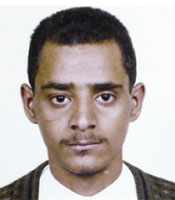
Yemeni poets behind Gitmo’s bars [Archives:2007/1114/Front Page]
December 24 2007
 |
SANA'A, Dec,19 ) Adnan Farhan Abdul Latif, 28, was in Pakistan looking for medical treatment – he had an injury from an accident in 1994, and was looking around the world for affordable treatment. In 2004, Pakistani forces detained him and turned him over to the United States for a $5,000 bounty, after which he became a Guantanamo detainee.
Latif spent his first weeks at Camp X-Ray in an open-air cage, exposed to the tropical sun, without shade or shelter from the wind that buffeted him with sand and pebbles. His only amenities were a bucket for water and another for urine and feces.
He has also been exposed to IRF, a term used to describe “immediate reaction force.”
According to Latif's American lawyer, a group of soldiers wearing body armor rushed into his prison and beat him. After the beating, one of his eyes was swollen shut, the other was black and blue, and he had contusions all over his body. Once he was beaten and sprayed with pepper spray, apparently, he stated, for having stepped over a line painted on the floor of his cell while his lunch was being passed through the food slot of his door
American lawyer Marc Falkoff described Latif as a small, thin Yemeni man with a scraggly beard. He recalled, “I first met Adnan Farhan Abdul Latif soon after I filed a habeas corpus petition on his behalf in late 2004. We were sitting in an interview cell, really a retrofitted storage container, at Camp Echo in Guantanamo Bay, Cuba. Across the table, Latif sat with his arms crossed and his head down. The guards had removed his handcuffs, but when he shifted his weight his leg irons clanged and echoed in the bare room. The irons were chained to an eyebolt on the floor. Guards were stationed outside the door, and a video camera was visible in the corner.”
Early this year, Latif began a hunger strike, which the military countered by force-feeding him liquid nutrients, inserting a tube up his nose and into his stomach.
Hunger striking wasn't the only method that Latif used to express his pain, and his protests against the mistreatment that Guantanamo prisoners receive. He transferred his suffering to poetry, for example writing:
They are artists of torture,
They are artists of pain and fatigue,
They are artists of insults
and humiliation.
Where is the world to save us
from torture?
Where is the world to save us
from the fire and sadness?
Where is the world to save
the hunger strikers?
Latif's \”Hunger Strike Poem


